VOL. 9 Nº 1 ENERO – ABRIL 2018 BUCARAMANGA, COLOMBIA
E-ISSN: 2346-3414
RESEARCH ARTICLE
Factors related to the application of nursing care process in Colombian hospitals
Fatores relacionados à aplicação do processo de enfermagem em instituições hospitalares na Colômbia
Factores relacionados con la aplicación del proceso de enfermería en instituciones hospitalarias de Colombia
Oscar Alexander Gutiérrez Lesmes1, Cesar Augusto Torres2, Nelly Johanna Loboa Rodríguez3
1MSc Environmental Management, Adjunct Assistant Professor, School of Public Health, Nursing Program, University of the Llanos, Villavicencio, Colombia. Corresponding Author. E-mail address: oagutierrez@unillanos.edu.co http://orcid.org/0000-0002-5181-0236
2Nurse, Young Researcher of the Care Group, University of the Llanos, Villavicencio, Colombia. cesar.torres.munoz@unillanos.edu.cohttp://orcid.org/0000-0003-2600-7027
3MSc Public Health, Adjunct Assistant Professor, School of Public Health, Nursing Program, University of the Llanos, Villavicencio, Colombia. johannaloboa@unillanos.edu.co http://orcid.org/0000-0001-8999-5072
Article Information
Received on September 28th, 2017.
Accepted on December 4th, 2017.
How to cite this article: Gutiérrez OA, Torres CA, Loboa NJ. Factores relacionados con la aplicación del proceso de enfermería en instituciones hospitalarias de Colombia.Rev Cuid. 2018; 9(1): 2007-16. http://dx.doi.org/10.15649/cuidarte.v9i1.480
![]() ©2018 University of Santander. This is an open-access article distributed under the terms of the Creative Commons Attribution License (CC BY-NC 4.0), which allows unlimited use, distribution and reproduction in any medium, provided that the original author and source are duly cited.
©2018 University of Santander. This is an open-access article distributed under the terms of the Creative Commons Attribution License (CC BY-NC 4.0), which allows unlimited use, distribution and reproduction in any medium, provided that the original author and source are duly cited.
Abstract
Introduction: The application of the nursing care process benefits patients’ health and promotes professional autonomy. Objective: To describe the application of the nursing care process by nursing professionals when providing care in Colombian Orinoquia hospitals. Materials and Methods: A cross-sectional, descriptive study was conducted through a structured interview. A non-probability sample was made up of 100 hospital nurses from highly complex healthcare centers. Summary measures and odds ratios were calculated. Results: 84% were women with an average age of 31 ± 9.1 years and the average number of patients per shift was 12.2 ± 15.5. 59% reported applying the nursing process and 98% reported lack of time as a factor for the non-application of the nursing care process. A statistically significant association was found in relation to the increase in the application of the nursing care process when considered a care facilitator (OR: 4.52; 95% CI: 1.1-18.2) and when nursing professionals find application and relation to the university training (OR: 4.06; 95% CI: 1.7-9.5). Discussion and Conclusions: The possibility of applying the nursing care process increases due to factors such as the perception of benefits and the level of appropriation by nursing professionals, but it is not limited to work or academic conditions.
Key words: Nursing Process; Nursing Care; Nursing; Hospital Nursing Staff.
Resumo
Introdução: A aplicação do processo de enfermagem beneficia a saúde do paciente e promove a autonomia da profissão. Objetivo: Descrever a aplicação do processo de enfermagem dos profissionais de enfermagem da área hospitalar na Orinoquia colombiana no momento da prestação de cuidado. Materiais e Métodos: Realizou-se um estudo descritivo transversal, utilizando uma entrevista padronizada, amostra não probabilística composta por 100 enfermeiros da área hospitalar, de centros de prestação de alta complexidade, foram calculadas medidas de resumo e razões de vantagens. Resultados: 84% eram mulheres, idade média: 31 ± 9.1 anos; número médio de pacientes por turno: 12.2 ± 15.5; 59% relataram aplicar o processo de enfermagem, 98% referem falta de tempo como fator para não aplicação do processo de enfermagem; foi encontrada associação estatisticamente significativa para aumentar a aplicação do processo de cuidados de enfermagem quando este é considerado como um facilitador para prestar cuidados (OR: 4.52 IC95%: 1.1-18.2); quando o profissional de enfermagem encontra aplicação e relação com a teoria recebida na universidade (OR: 4.06 IC95%: 1.7-9.5). Discussão e Conclusões: A possibilidade de aplicar o processo de enfermagem aumenta por fatores como a percepção de benefícios, o nível de apropriação que têm os profissionais de enfermagem, e não se limitou a condições de trabalho ou acadêmicas.
Palavras chave: Processo de Enfermagem; Cuidados de Enfermagem; Enfermagem, Recursos Humanos de Enfermagem no Hospital.
Introducción: La aplicación del proceso de enfermería beneficia la salud del paciente y promueve la autonomía de la profesión. Objetivo: Describir la aplicación del proceso de enfermería de los profesionales de enfermería del área hospitalaria en la Orinoquia colombiana al momento de brindar cuidado. Materiales y Métodos: Se realizó un estudio descriptivo transversal mediante entrevista estandarizada. Muestra no probabilística constituida por 100 enfermeros del área hospitalaria, de centros de atención de alta complejidad. Se calcularon medidas de resumen y razones de ventajas. Resultados: 84% eran mujeres con una edad promedio de 31 ± 9,1 años y el promedio de pacientes por turno fue de 12,2 ± 15,5. 59% refirieron aplicar el proceso de enfermería y 98% refieren la falta de tiempo como factor para la no aplicación del proceso de enfermería. Se encontró asociación estadísticamente significativa para aumentar la aplicación del proceso de atención de enfermería cuando este es considerado como un facilitador para brindar el cuidado (OR: 4,52 IC95%: 1,1-18,2) y cuando el profesional de enfermería encuentra aplicación y relación con la teoría recibida en la universidad (OR: 4,06 IC95%: 1,7-9,5). Discusión y Conclusiones: La posibilidad de aplicar el proceso de enfermería aumenta por factores como la percepción de beneficios y el nivel de apropiación que tienen los profesionales de enfermería, más no se limitó a condiciones laborales o académicas.
Palabras clave: Proceso de Enfermería; Atención de Enfermería; Enfermería, Personal de Enfermería en Hospital.
INTRODUCTION
The Nursing Care Process (NCP) is defined as a systematic method inasmuch as it is a sequential, cyclical, and controlled scheme aimed at managing nursing care1-4, which should be considered vitally important as it is one of the most important methodological foundations in the recognition of nursing as a discipline2,5,6. The nursing care process is the application of the scientific method to healthcare practices5.7.
After the publication of the process standards by the American Nurse Association in 1973, the application of the scientific method in the nursing practice became important, turning out to be the tool used for the development of nursing activities focused on its subject of study: care.
Now the nursing care process has been accepted worldwide as the framework of nursing practice8, ensuring suitable nursing care through this process9. It emulates the steps of the scientific method so as to establish a structure to intervene in the real or potential needs of patients through activities, that once applied and evaluated, their feedback is used to redirect them to achieve greater effectiveness2,5. For the development of the profession, it is necessary to organize activities in the interest of care so that nursing professionals are clear about the meaning, application and importance of the nursing care process (NCP) in their assistance practice as NCP encourages critical thinking, research, and development of own knowledge that contribute professional autonomy and justify the scientific endeavor of the profession.
Therefore, this study is aimed at determining the factors for the application of the nursing care process in Colombian Orinoquia hospitals (Arauca, Casanare, Meta, Vichada), considering the limited existing research both at the country and the Orinoquia region levels. This study will encourage feedback, which will serve as a product that contributes to academic development and possibly to decision making to improve the profiles of nurses being trained, increasing graduates’ knowledge and update.
MATERIALS AND METHODS
Type of Study and Population
A cross-sectional descriptive study was conducted with nursing professionals from the second- and third-level healthcare hospitals in the Colombian Orinoquia (Arauca, Casanare, Meta, Vichada). The target population was 311 nursing professionals working in 8 regional second- and third-level hospitals in the Colombian Orinoquia. As the population census was not available, non-probability sampling was conducted and intentionally selected, made up of 100 nursing professionals (32% of the target population) and weighted based on the nursing population of each hospital to select the sample in each hospital.
Measurement Process and Data Collection
For data collection, the researchers met each nursing professional in their workplace in person, socializing the informed consent form so that those who decided to freely and spontaneously participate in the study were subjected to a structured interview. The instrument was designed by the researchers and validated by experts in which demographic, academic, work variables were analyzed, as well as direct care activities and the conceptualization and application of the nursing care process. The inclusion criteria were to be a nursing professional working in hospitals, healthcare service providers offering second and/or third level of care in Colombian Orinoquia hospitals.
Statistical Analysis
The database was built using the information collected. An exploratory analysis was conducted using quantitative variables in which the distribution of the variables was determined (extreme values, symmetries, kurtosis, types of distribution, and lost data). Relative frequencies were analyzed (fashion, erroneous data, and missing data) for the qualitative variables. After data validation, the information was analyzed using descriptive statistics, univariate analysis (proportions, central tendency, and dispersion) and unadjusted odds ratio (OR), while confidence interval and significance were calculated for bivariate analysis. Means were calculated for numerical variables, while the comparison of quantitative variables was carried out by Ji2. The analysis was done using SPSS software licensed for the University of the Llanos, considering a p-value less than 0.05 as statistically significant.
Ethical Considerations
According to resolution 8430 of 1993 of the Colombian Ministry of Health, the study is considered risk-free study. Voluntary participation and anonymity were ensured through informed consent prior to obtaining the information. Obtained results were followed.
RESULTS
Table 1 shows the demographic and work characteristics of nurses in the Orinoquia region. 84% of nurses are female whose predominance is similarly observed in each department. The average age is 31 years old with a standard deviation (SD) of 9.1 years. As for work characteristics, the hospital work experience is 7 years on average with a SD of 7.3 years, the average number of patients per shift is 17.2 with a SD of 15.5 patients and the working conditions reflect that 77% of the nursing professionals are hired directly by the hospital, while the remaining 23% are outsourced through a worker cooperative. Concerning the type of contract, 53% have an open-ended contract, 30% have a service provision contract, and 17% have a fixed-term contract, for which the average monthly salary received by nurses is 2,050,000 COP with a SD of 360,779 COP, with salaries ranging from 1,330,000 COP to 3,500,000 COP.
Table 1. Demographic and work-related characteristics of nurses by Orinoquia department
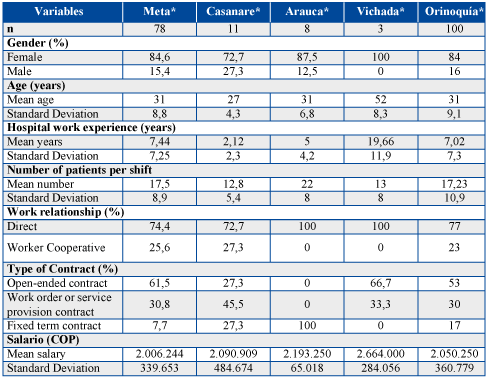
*Percentages should be vertically interpreted. n: absolute frequency, %: relative frequency.
Table 2 indicates the university from which the nurses who provide clinical care in the Orinoquia region graduated, 71% are graduates of the University of the Llanos, followed by 5% from the University of Applied and Environmental Sciences and the National University, the Cooperative University of Colombia, 3% from the Pedagogical University of Tunja and the Simon Bolivar University. The ‘other universities’ category is made up by the San Gil University Foundation, the Sanitas University Foundation, the University of Pamplona, the University of Magdalena, the University of the North, the University of Tolima, the Metropolitan University of Barranquilla, the Popular University of Cesar with a graduate in each Orinoquia hospital. As for postgraduate studies completed by nurses, it was found that 93% have not completed any postgraduate studies and only 3% have completed postgraduate studies related to healthcare (MSc Nursing, PgD Oncology and Auditing, PgD Family Health).
Table 2. Academic characteristics of nurses in the Colombian Orinoquia
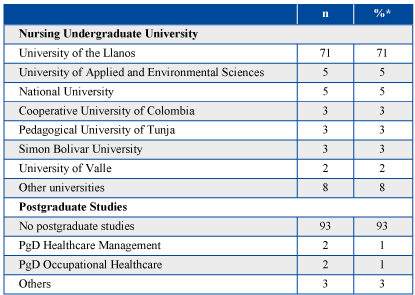
*Percentages should be vertically interpreted. n: absolute frequency, %: relative frequency.
Table 3 shows the nurses' perception of the nursing care process study. 4% do not consider the application of NCP to be important for work performance, 11% consider that the application of NCP does not facilitate patient care, and 45% consider that the NCP application in some way limits their work during shift. The highest proportion of nurses who do not consider it important is located in Arauca and Meta at 12.5% and 3.8% respectively, compared to the 12.5% of Arauca nurses, 11.5% of Meta nurses and 9.1% Casanare nurses who do not consider the NCP to be useful for patient care. Additionally, the highest proportion of nurses who consider the NCP application as something that somehow limits their work during shift is located in Meta at 51.35%, followed by Arauca at 37.5%, Vichada at 33.3% and Casanare at 9.1%.
Table 3. Nurses' perception of NCP application
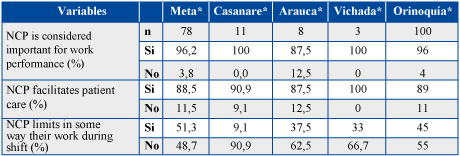
*Percentages should be vertically interpreted. n: absolute frequency, %: relative frequency.
Table 4 shows the proportion of nurses in the study who have reported applying NCP in patient care of which 59% reported applying NCP. Regarding the intervening factors in the NCP application, nurses referred that 98% lacked time, 14% considered that NCP application was not part of their job duties, 6% said that university training was insufficient, and 2% had insufficient knowledge.
Table 4. NCP application and intervening reasons when NCP is not applied
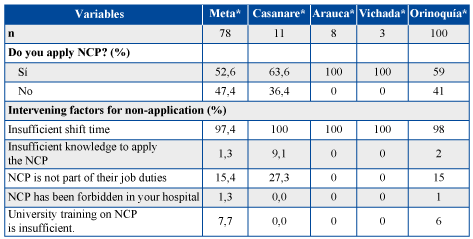
*Percentages should be vertically interpreted. n: absolute frequency, %: relative frequency.
Table 5 shows the factors associated with a greater NCP application by nurses working in the Orinoco hospitals included in the study. The factors in which a statistically significant association was found to increase NCP application were that NCP is considered to facilitate patient care with an odds ratio (OR) of 4.52, 95% CI (1.1 -18.2); the association between application and relationship based on university training, with an OR of 4, 95% CI (1.7 -9.5); and the third factor with an OR of 4.57 is that NCP application is considered to be important for work performance, although no statistical significance was found for this factor.
Table 5. Associated factors in NCP application

OR: Odds ratio. CI: Confidence Interval
Table 6 shows the effects of NCP application on the activities of those nurses who participated in the study and patient benefits. For this analysis, the NCP application was taken as an independent variable and nursing activities as dependent variables. The characteristics in which a statistically significant association was found were related to an increase in nursing diagnoses for patients (3.39 OR, 95% CI (1.45 - 7.9)) and improvements in the performance of direct care actions (3.48 OR, 95% CI (1.09 - 11.1)).
Table 6. Effect on nursing professional activities and patient benefits when NCP is applied
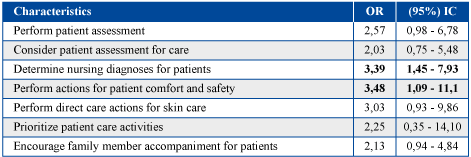
OR: Odds ratio. CI: Confidence Interval
The reference group corresponds to those nurses who do not apply NCP.
DISCUSSION
The sample studied in the Orinoquia region showed a majority of a young adult female population similarly distributed to that found in the research conducted by Gutiérrez5, Cogollo10, Rojas & Durango1, Duque11, Batista & Alvarado12 and Caballero et al13.
As for the university from which nursing professional are, 71% are graduates of the University of the Llanos as it is their zone of influence. A similar finding occurred in the Cabarcas study conducted in Cartagena, where 79% of the professionals were graduates of the University of Cartagena14; 93% lacks postgraduate studies in those interviewed professionals working in the Orinoquia region, which is higher than that registered in Cartagena, Colombia at 72%14, and also higher than that registered in the State of Mexico, Mexico at 83%.
The average salary received by nurses working in Orinoco hospitals is 2,050,250 pesos, ranging from 1,330,000 pesos to 3,500,000 pesos. In the study conducted by Cogollo, 67% of the nursing professionals received monthly salaries between 1,384,500 and 1,846,0005 in Cartagena (Colombia), with an average of 923,000. Based on this, the nursing staff of this study reported that working conditions were deficient in terms of economic retribution11, showing a better remuneration for nursing professionals in the Orinoquia. As for the type of work relationship, 23% is outsourced through worker cooperatives in the Orinoquia, a situation different from that reported by Cogollo in Cartagena (Colombia) where 44% of professionals have work relationships through worker cooperatives10 and 63% in Medellín (Colombia) as reported by Duque11. According to the National Association of Nurses of Colombia (ANEC in Spanish), this type of work contract implies that the professionals under this work relationship are not workers with labor rights within the labor regime. This outsourcing through worker cooperatives is not responsible for the payment established by law to guarantee access to social security for workers10-14.
As for the workload, the number of patients per shift that a nurse must care for is 17.23 in the Orinoquia. In 2008, the average number of patients that hospital nurses cared for was 30 patients per shift in Villavicencio, Meta5, showing a decrease in the number of patients in the region. The number of patients per shift becomes important because the nurse-patient ratio influences the quality of care provided in healthcare services and a high allocation of patients per nurse is translated into a decrease in the quality of services provided to patients15. An average of 24 patients per shift is reported in the study conducted by Duque11 and 18 patients in Caballero et al. The average numbers that have reported are similar.
98% of the nurses perceive that NCP application is important for work performance, 89% consider that NCP also facilitates patient care, although 45% consider that NCP in some way limits their work during shift. In other studies, the perception of NCP importance for work performance was similar as nurses also consider that it facilitates problem-solving and decision-making in nursing care, being useful for patient care and benefits and equally important for professional development1,6,11,14,16-18. The NCP development is also perceived as an activity that in some way limited the actions of nursing professionals1,5.
As for the application of the nursing care process, 59% of the surveyed professionals in the Orinoquia stated that they apply NCP in their daily hospital work, compared to that reported by Gutiérrez in a study conducted in a city of the Orinoquia in which 35.4% reported applying NCP, that may be evidence of an increase by 20165. Other studies showed that the proportion of nursing professionals who apply NCP was 78.5% in Medellin (Colombia) according to Rojas & Durango1; 70% in Lima and Callao (Peru) according to Sánchez, Zegarra & Pacheco19; 41% in the State of Mexico (Mexico) according to Angeles et al.18; 26.2% and 59.8% in Chile according to Campos, Jaimovich, Wigodski & Aedo17 and Caballero et al1, respectively; finally, 64,8% in Guskoa (Basque Country) according to Huitzi-Egilegor, et al18. The application of the nursing care process in the Orinoquia has not been consolidated yet, although it is above the proportions obtained in other territorial units.
According to the sample of nurses in the Orinoquia, insufficient time is the main factor for not being able to apply the NCP, similar to what Cabarcas & Caballero14, Gutiérrez5, Duque11, Sánchez, Zegarra & Pacheco19, Caballero et al13, Batista & Alvarado 201512 found. These authors also report other factors such as work overload, the number of patients, insufficient knowledge, and the assignment of administrative functions to be completed within the shift time.
In the exploration of work or academic factors associated with the non-application of NCP by the Orinoquia professionals selected in the study sample, no statistically significant relationships were found.
In addition, a statistically significant association was found with the NCP application. These factors were related to when nurses consider that NCP facilitates patient care (OR: 4.52, 95% IC: 1.1 -18.2); when nurses find NCP application and relationship with university training (OR: 4.06, 95% IC: 1.7 - 9.5). The benefits and usefulness perceived by nurses likely encourage NCP application, although factors affecting the possibility of applying NCP have been reported such as the institutional hospital context, the high number of patients, lack of methodological knowledge, lack of records, and assignment of administrative duties, lack of time5. The major problem could be nurses’ attitude, as well as the level of appropriation that nursing professionals have regarding NCP since the results in multiple studies have been similar1,5.
A statistically significant association was found for the benefits of applying NCP perceived by nurses such as increased performance of nursing diagnosis (OR: 3.39, 95% IC 1.5-7.9) and increased performance of actions for patient comfort and safety (OR: 3.48, 95% IC: 1.09-11.1). These benefits demonstrate the usefulness of the nursing care process in terms of improving quality of care, decreasing adverse events and thus improving the health status6,20,21of patients (people involving their families6).
There were limitations in the process of interviewing nursing professionals due to geographical access, the distances that had to be covered for the process in the departments of Arauca, Casanare and Vichada, as well as the limited time of nursing professionals to help researchers. These were operational limitations that did not affect the conclusions.
CONCLUSIONS
The application of the nursing care process in the Orinoquia region is in agreement with the results obtained in different studies. NCP perception is directed toward the recognition of the benefits that patients receive when receiving NCP-based care and the development of nursing autonomy as a discipline. The lack of time is the most given reason for not being able to apply NCP in Orinoquia similarly to the rest of the published studies. Finally, it is clear that professionals who have a better perception of the NCP usefulness tend to apply it more regularly and that the NCP application benefits professional practice and patient health.
Conflict of interest: The authors declare that they have no conflict of interest.
REFERENCES